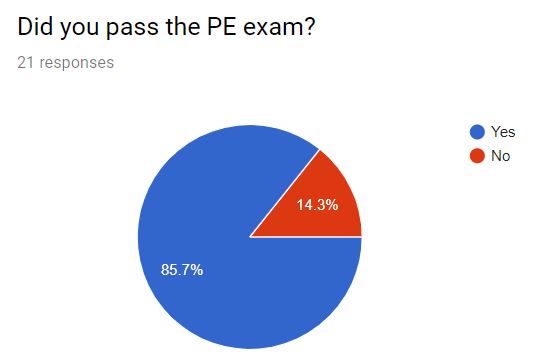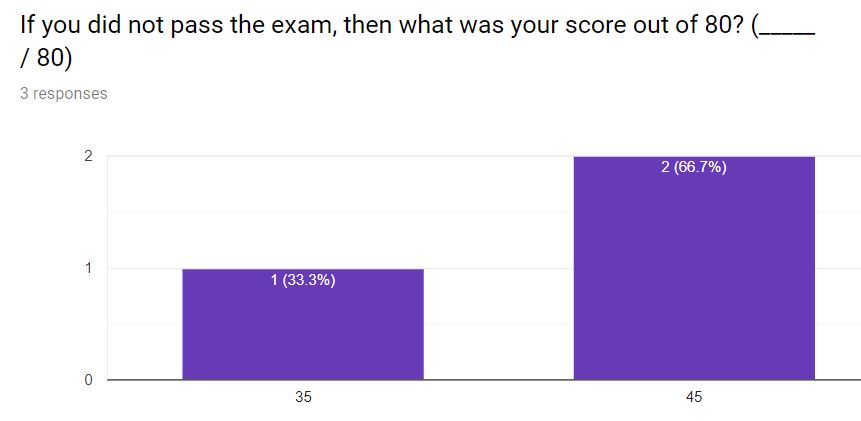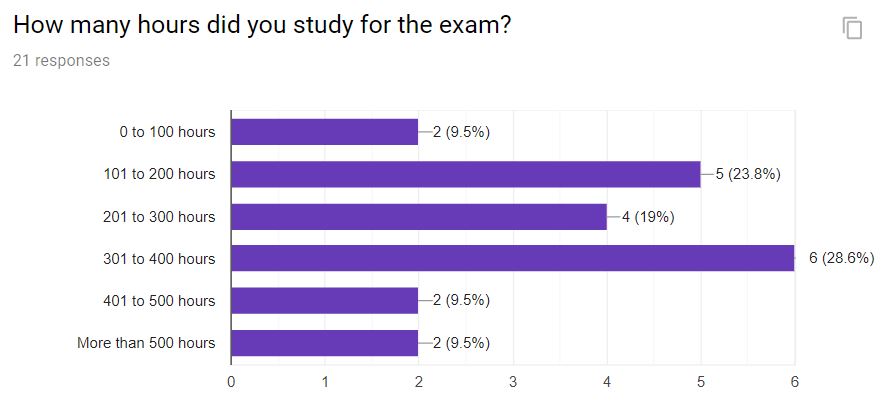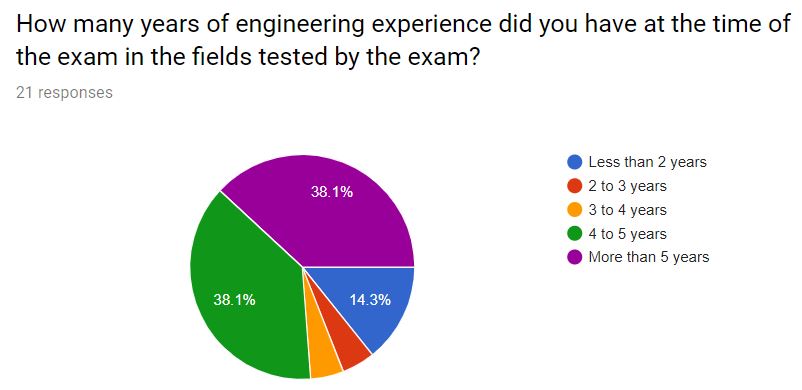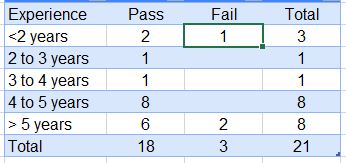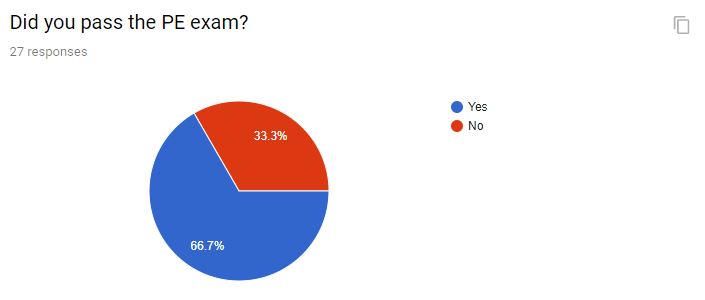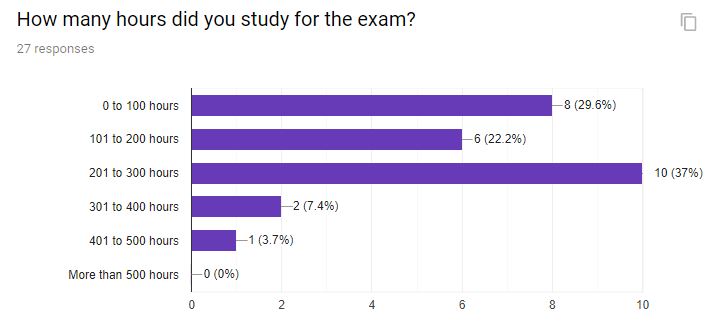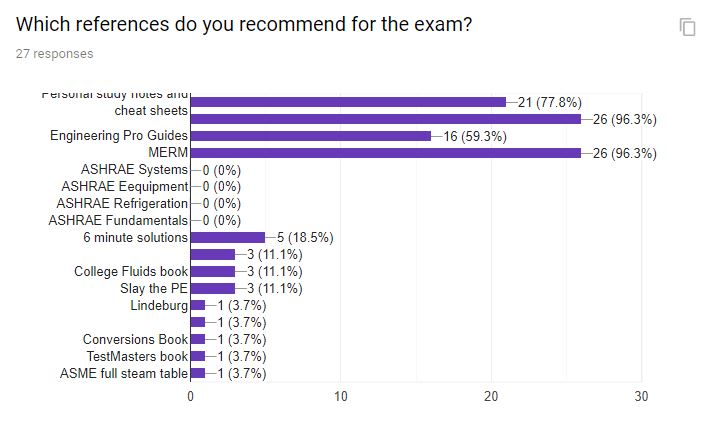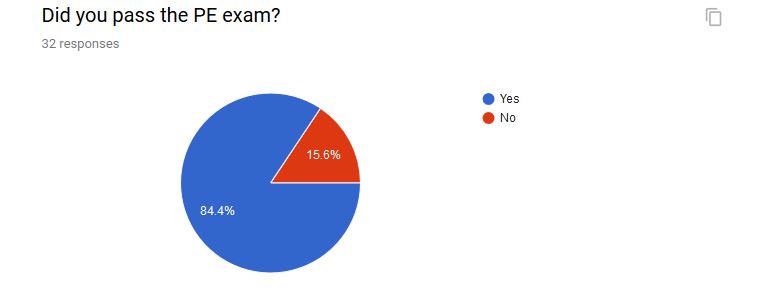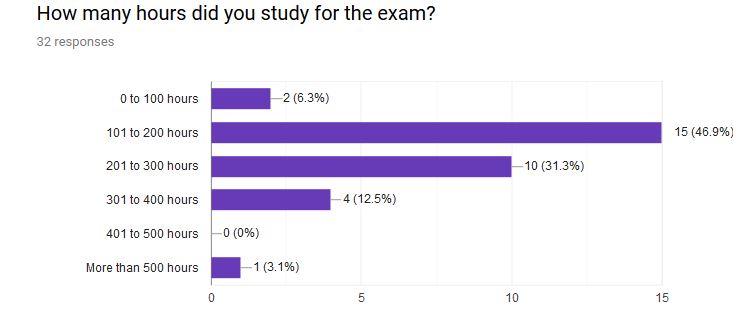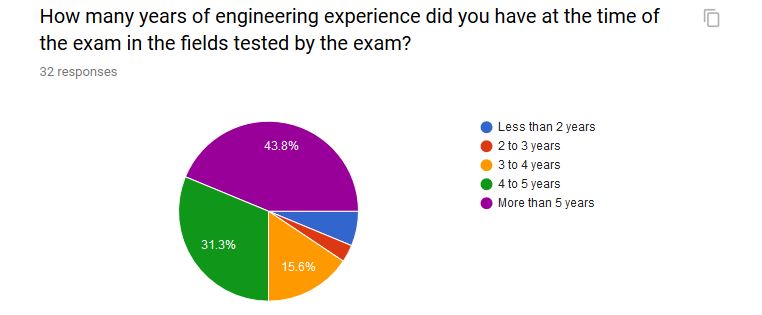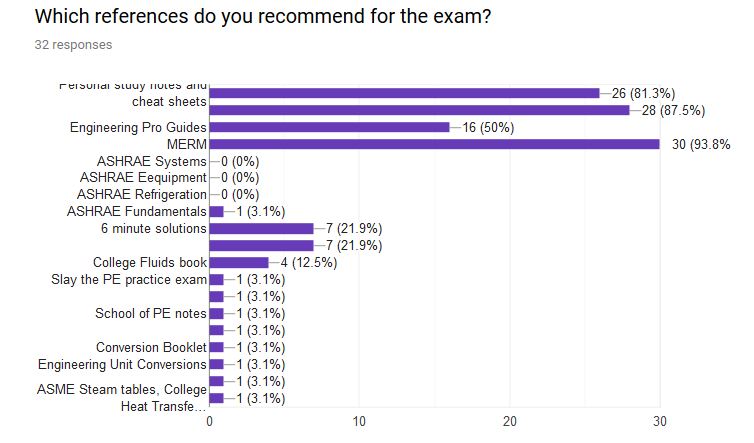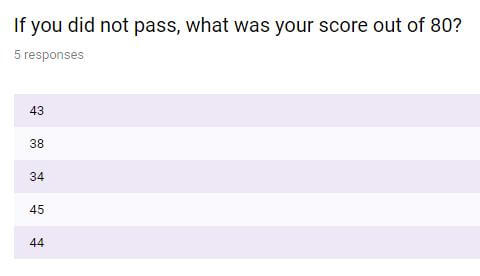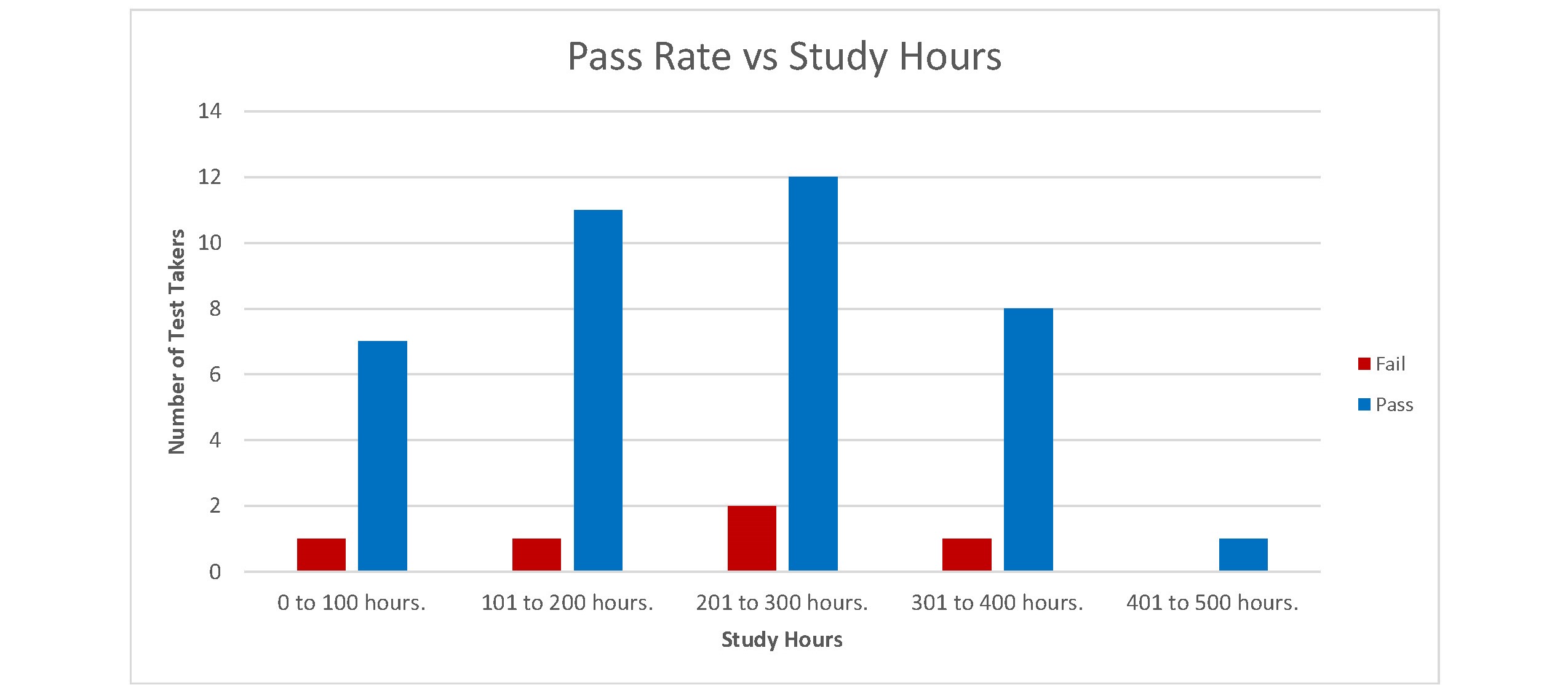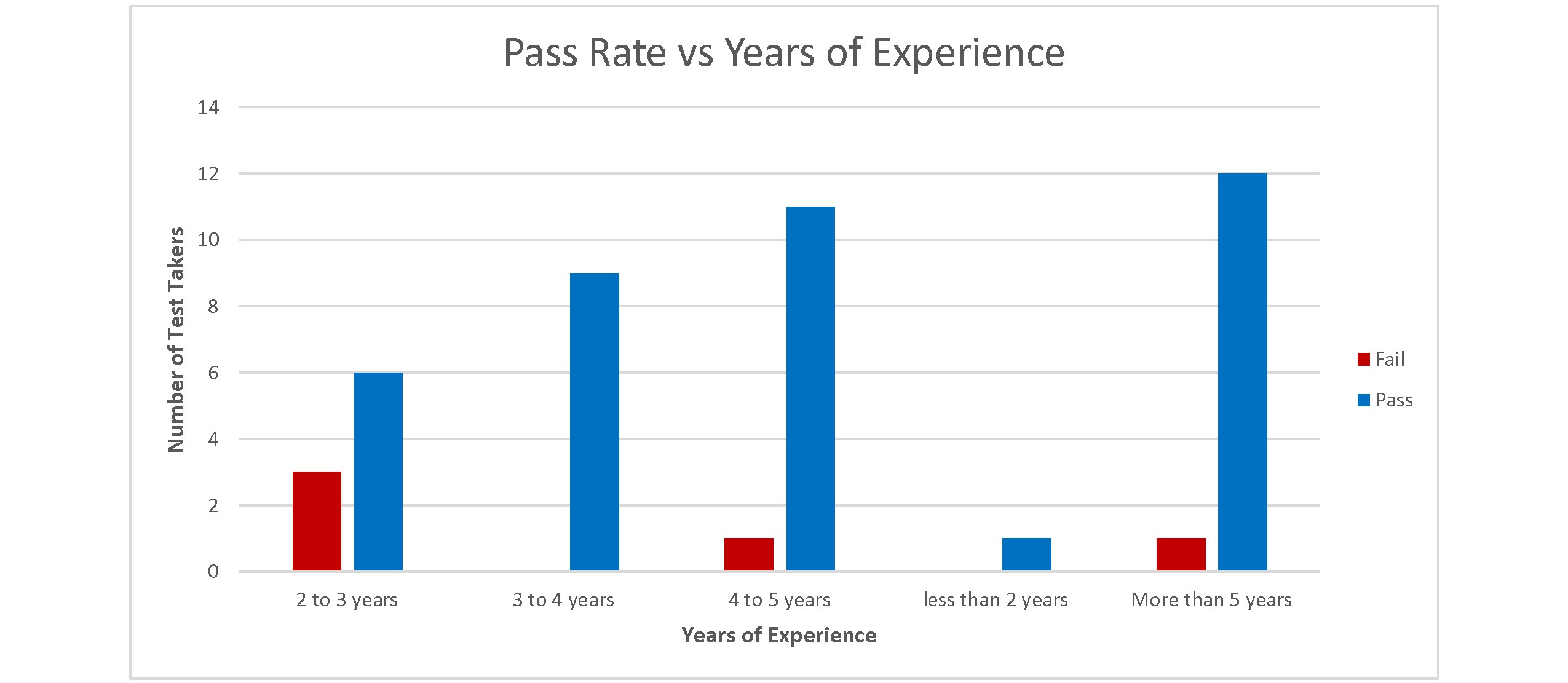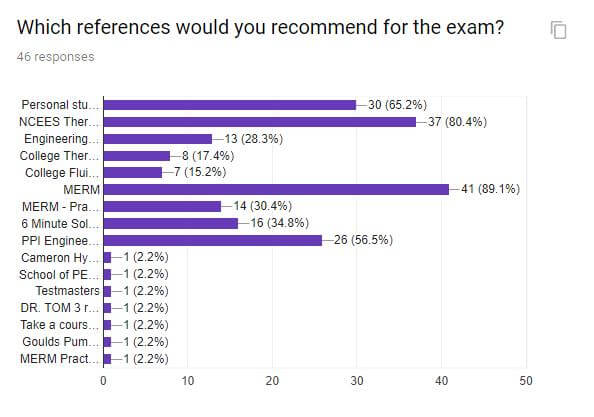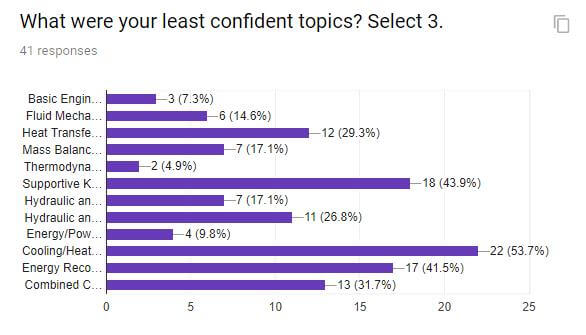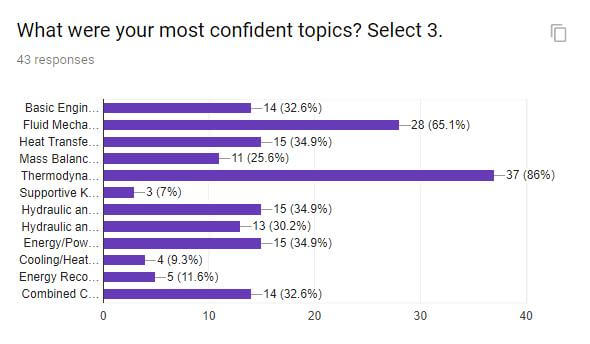
Engineering Pro Guides is your guide to passing the Mechanical & Electrical PE and FE Exams
Engineering Pro Guides provides mechanical and electrical PE and FE exam technical study guides, practice exams and much more. Contact Justin for more information.
Email: contact@engproguides.com
EXAM TOOLS
Thermal & Fluids - PE Results Survey
Introduction
After every PE exam, I conduct an online survey with as many PE exam test takers that I can find. I primarily use my website, Engineering Pro Guides and Engineer Boards to find test takers to take the survey. The survey provides insight into an estimated passing score, how well test takers do based on experience and number of hours studied, which areas of the exam are difficult or easy. The raw results of the survey are shown on the links below. There is additional discussion within the technical study guide and also shown below on this webpage. I have also summarized the top recommendations from the past test takers that consistently appear throughout each exam.
- 2020-2023 CBT Thermal Results Survey
- October 2019 Thermal Results Survey
- April 2019 Thermal Results Survey
- October 2018 Thermal Results Survey
- April 2018 Thermal Results Survey
- October 2017 Thermal Results Survey
- April 2017 Thermal Results Survey
Recommendation 1: Start with Practice Exams
Consistently, many people have expressed regret over studying from textbooks and focusing on theory & vague concepts, as opposed to looking at practice exams. By starting with practice exams, you can get a better idea of the type of material that is tested on the PE exam. You can also determine your weak and strong areas. With this information, you can develop a plan of attack. You can determine the topics that you need to study and you can also determine better as to what subtopics within the larger topics will be on the actual exam. Basically, before you start studying, you need to get a better idea as to what you have to study. If you focus on a reference manual without a plan, then you will waste a lot of valuable study time.
Recommendation 2: More Practice Problems with Deliberate Practice
The second most common recommendation is to just do more practice problems. But there are caveats that go with this recommendation. First, make sure the practice problems fit within the NCEES Thermal & Fluids topics and are not overly complex or simple. The problems should take roughly 6 minutes to do. The second caveat is that you must complete the problems with deliberate practice. This means that when you go through the problem, don't just look at the solution. You should understand why the answer is the way it is and you should also extrapolate from that one problem into all the other types of problems that could arise. For example, if the problem gives you flow rate and asks you to find pressure drop, then you should be able to conduct a problem given pressure drop in order to calculate flow rate. You should also extrapolate the problem into different scenarios, like what if the fluid was more viscous or more dense, then how would the solution change.
Recommendation 3: Practice with Metric Units
Thermal and Fluids is the one Mechanical PE topic that requires you to know metric and imperial units. The HVAC and the Machine Design exams primarily focus on imperial units, but in the thermal and fluids field, metric units are often used in practice here in the USA.
October 2019 Survey Summary
This summary is taken from the raw data compiled from the October 2019 Surveys.
Number of Test Takers (858) vs Number of Survey Results (27)
The survey is only as good as the number of test takers that take the survey. According to the NCEES website, there were 647 compared to 498 first time takers in April 2019 and 211 compared to 211 repeat takers in April 2019, with a total of 858 compared to 709 Thermal and Fluids PE Exam test takers on April 2019. The survey had 21 responses or 2.4% of the total test takers. As you go through the results of the survey, please remember that only a small percentage of the test takers took the survey so you should be careful when assigning authority to the results of the survey.
Survey Pass Rates (86%) vs NCEES Pass Rates(60%)
The NCEES pass rates are 68% for the 647 first time test takers and 34% for the other 211 test takers. This results in an overall pass rate of 60%. The survey test takers have a pass rate of 86%. It may be that those who pass are more inclined to take the survey.
Estimated Cut Score: 46/80
The estimated cut score is based on the highest fail score received in the survey. The highest fail score recorded was 45. Please remember that there were only 3 people who reported a fail score. Engineer forums for the October 2019 PE exam also reported fail scores between 35 to 45. I believe a safe goal is to achieve a 60 out of 80 or 75%.
Ideal Number of Study Hours: Around 100-200 hours
The majority of the test takers that passed the exam study around 0 to 200 hours at a pass rate of 100%. It seems like there is not information to make a correlation between studying more or less and the pass rate. The majority of people study between 100 and 400 hours. Rarely do people study more than 400 hours. On average the 200 hours results in 10 to 20 hours per week of studying. Studying too much seems to correleate with failing.
Ideal Years of Experience: 4 to years
The majority of the test takers have 4 to 5 years of experience. Those with more than 5 years of experience have a pass rate of 75%. This seems to indicate that the PE exam is geared more towards engineers with more practical experience, but who are not more than 4 years out of college/university.
Recommended References
This is the list of the recommended references in order of percentage of people that recommended the reference.
- MERM
- Personal Study Notes & Cheat Sheets
- NCEES Sample Exam
- Engineering Pro Guides Products (Technical Study Guide, Full Exam and/or References Exam
- 6 Minutes Solutions
- College Thermodynamics Book
- College Fluids Book
Weak Areas
The weak areas in this exam based on the feedback from the survey are shown below. In the past surveys, the weak areas have always included HVAC, which encompasses HVAC equipment, psychrometrics and heat transfer. Other topics that have always been included have been cycles (vapor compression, combined and power)
- HVAC
- Heating Value
- Supportive Knowledge
- Psychrometrics
- Heat Transfer
- Thermodynamics
- Statics and Dynamics
- Hydraulic Fluids Applications
- Combined Power Cyles
- Refrigeration Cycle
- Pipe Systems
- Pressure Vessels
- Psychrometrics
- Mach Number
- Compressed Air Flow
April 2019 Survey Summary
This summary is taken from the raw data compiled from the April 2019 Surveys.
Number of Test Takers (709) vs Number of Survey Results (27)
The survey is only as good as the number of test takers that take the survey. According to the NCEES website, there were 498 compared to 524 first time takers in October 2018 and 211 compared to 205 repeat takers in October 2018, with a total of 709 compared to 729 Thermal and Fluids PE Exam test takers on October 2018. The survey had 27 responses or 3.8% of the total test takers. As you go through the results of the survey, please remember that only a small percentage of the test takers took the survey so you should be careful when assigning authority to the results of the survey.
Survey Pass Rates (67%) vs NCEES Pass Rates(63%)
The NCEES pass rates are 69% for the 498 first time test takers and 48% for the other 211 test takers. This results in an overall pass rate of 63%. The survey test takers have a pass rate of 67%.
Estimated Cut Score: 50/80
The estimated cut score is based on the highest fail score received in the survey. The highest fail score recorded was 49.
Ideal Number of Study Hours: Around 200-300 hours
The majority of the test takers that passed the exam study around 200 to 300 hours at a pass rate of 100%. It seems like there is not information to make a correlation between studying more or less and the pass rate. The majority of people study between 100 and 300 hours. Rarely do people study more than 300 hours. On average the 200 hours results in 10 to 20 hours per week of studying.
Ideal Years of Experience: More than 3 years
The majority of the test takers have more than 5 years of experience. Besides the one outlier with 2-3 years of experience, more people appear to pass as years of experience increases. Those with more than 3 years of experience have the highest pass rates with ranges of 67% to 73%. This seems to indicate that the PE exam is geared more towards engineers with more practical experience, rather than to engineers right out of college/university.
Recommended References
This is the list of the recommended references in order of percentage of people that recommended the reference.
- MERM
- NCEES Sample Exam
- Engineering Pro Guides Products (Technical Study Guide, Full Exam and/or References Exam
- 6 Minutes Solutions
- Slay the PE
- College Thermodynamics Book
- College Fluids Book
- ASME Steam Table
Weak Areas
The weak areas in this exam based on the feedback from the survey are shown below. In the past surveys, the weak areas have always included HVAC, which encompasses HVAC equipment, psychrometrics and heat transfer. Other topics that have always been included have been cycles (vapor compression, combined and power)
- HVAC
- Supportive Knowledge
- Thermodynamics
- Hydraulic Fluids Applications
- Combined Power Cyles
- Refrigeration Cycle
- Pipe Systems
- Pressure Vessels
- Psychrometrics
- Compressed Air Flow
October 2018 Survey Summary
This summary is taken from the raw data compiled from the October 2018 Surveys.
Number of Test Takers (729) vs Number of Survey Results (32)
The survey is only as good as the number of test takers that take the survey. According to the NCEES website, there were 524 compared to 597 first time takers in October 2017 and 205 compared to 229 repeat takers in October 2017, with a total of 729 compared to 826 Thermal and Fluids PE Exam test takers on October 2017. The survey had 32 responses or 4.4% of the total test takers. As you go through the results of the survey, please remember that only a small percentage of the test takers took the survey so you should be careful when assigning authority to the results of the survey.
Survey Pass Rates (84%) vs NCEES Pass Rates(60.8%)
The NCEES pass rates are 69% for the 524 first time test takers and 40% for the other 205 test takers. This results in an overall pass rate of 60.8%. The survey test takers have a pass rate of 84%.
Estimated Cut Score: 46/80
The estimated cut score is based on the highest fail score received in the survey. The highest fail score recorded was 45.
Ideal Number of Study Hours: Around 200 hours
The majority of the test takers that passed the exam study around 200 to 300 hours at a pass rate of 100%. It seems like there is not information to make a correlation between studying more or less and the pass rate. The majority of people study between 100 and 300 hours. Rarely do people study more than 300 hours. On average the 200 hours results in 10 to 20 hours per week of studying.
Ideal Years of Experience: More than 3 years
The majority of the test takers have more than 5 years of experience. When you compare the pass rates based on years of experience, those with less than 3 years of experience had the lowest pass rate at 67%. Those with more than 3 years of experience have the highest pass rates with ranges of 80% to 100%. This seems to indicate that the PE exam is geared more towards engineers with more practical experience, rather than to engineers right out of college/university.
Recommended References
This is the list of the recommended references in order of percentage of people that recommended the reference.
- MERM
- NCEES Sample Exam
- Engineering Pro Guides Products (Technical Study Guide, Full Exam and/or References Exam
- 6 Minutes Solutions
- College Thermodynamics Book
- College Fluids Book
Weak Areas
The weak areas in this exam were as shown below in order of difficulty. In the past surveys, the weak areas have always included HVAC, which encompasses HVAC equipment, psychrometrics and heat transfer. Other topics that have always been included have been cycles (vapor compression, combined and power)
- HVAC, Psyhcrometrics & Heat Transfer
- Compressible Flow
- Cycles
October 2017 Survey Summary
This summary is taken from the raw data compiled from the October 2017 Surveys.
Number of Test Takers (826) vs Number of Survey Results (46)
The survey is only as good as the number of test takers that take the survey. According to the NCEES website, there were 597 first time takers and 229 repeat takers, with a total of 826 Thermal & Fluids PE Exam test takers on October 2017. The survey had 46 responses or 5.6% of the total test takers. As you go through the results of the survey, please remember that only a small percentage of the test takers took the survey so you should be careful when assigning authority to the results of the survey.
Survey Pass Rates (89%) vs NCEES Pass Rates(59%)
The pass rates on the survey indicate that 89.1% people surveyed passed the exam and 10.9% failed the exam. The NCEES website indicates that 67% of first time test takers passed the exam and 37% of repeat test takers passed the exam. The overall pass rate was 58.7%.
Estimated Cut Score: 46/80
The estimated cut score is determined by the highest fail score reported on the survey or on the Engineer Boards forum. The highest fail score was 45. This means that the possible passing score was 46. However, based on previous T&F surveys, the highest fail score reported was 53.
Ideal Number of Study Hours: Around 200 hours
The following graph shows the relationship between passing/failing and the number of study hours. Based on this graph, the number of failing test takers seems to be independent of hours studied. The number of passing test takers seems to increase with hours studied. However, there seems to be a sweet spot at the 201 to 300 hours of studying. The number of passing test takers peaks at the 201 to 300 level and goes down after this point.
Ideal Years of Experience: More than 3 years
The following graph shows the relationship between passing/failing and the number of years of experience. Based on this graph, it looks like the number of passing test takers increases with years of experience. The number of failing test takers seems to decrease as the number of year experience is decreased. One theory is that with an increase of years of experience, the application type problems should become easier.
Recommended References
More insight into the recommended references can be found on the link below. This link shows all the recommended references and which topics and subtopics they apply.
- MERM
- NCEES Sample Exam
- Engineering Pro Guides Products (Technical Study Guide, Full Exam and/or References Exam
- 6 Minutes Solutions
- College Thermodynamics Book
- College Fluids Book
Weak Areas
On the survey, each person was asked to choose three of their least confident topics. This question provides insight into which of the topics proves to be the most difficult for people. On the survey, test takers struggled with Cooling/Heating, Energy Recovery and Supportive Knowledge. The best insight to take from this information is that if you struggle in these areas, then you should not be too worried, because others struggled and still passed. However, if you want to set yourself apart from the other test takers then you should study these areas more diligently. Especially since these topics have a high amount of problems on the exam.
- HVAC, Psyhcrometrics & Heat Transfer
- Compressible Flow
- Cycles
Strong Areas
On the survey, each person was asked to choose three of their most confident topics. This question provides insight into which of the topics proves to be the easiest for people. On the survey, test takers did well in Thermodynamics and Fluid Mechanics. The best insight to take from this information is that if you struggle in these areas, then you SHOULD be worried, because people who passed did really well in these areas. You should study these areas more diligently. Especially since these topics have a high amount of problems on the exam.
- Thermodynamics
- Fluid Mechanicsw
